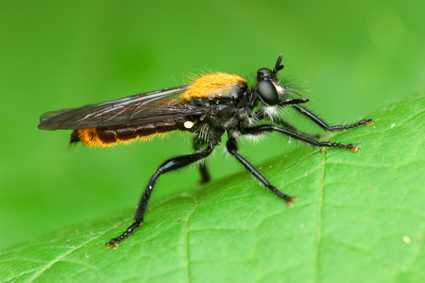Laphriinae sensu Dikow 2009a

Laphria aktis , image © Michael Thomas.
Laphriinae
– Dorsal margin of postocciput with triangular projection (42)
– apical “seta-like” sensory element situated apically in cavity on stylus (57)
– dorsal margin of prosternum with distinct flangelike projection (75)
– metkatepisternum large and visible between mesothoracic and metathoracic coxae (ventral view) (100)
– setae present on lateral metathoracic coxae (112)
– cell r1 closed, R1 and R2+3 meet at costa (131)
– R2+3 apex arching sharply anteriorly in 90 degrees angle (142)
– R4 strongly sinuate (144)
– female T10 lost or fused to cerci (172)
– male abdominal segments 1–6 well developed, T7–8 and S7 reduced while S8 is well developed (193)
Laphriinae is the oldest available family-group name within this clade and includes all genera, which had been previously assigned to Laphriinae and Laphystiinae by Papavero (1973) and Geller-Grimm (2004).
Andrenosomatini: Andrenosoma, Dasyllis, Hyperechia, Pilica, Proagonistes
– Female T10 is divided into two heavily sclerotized sclerites that are far apart (172)
– Distal maxillary palpomere laterally compressed and leaflike (13)
– prementum of labium dorsoventrally flattened (18)
– apex of labella of labium pointed (24)
– female with median sclerite at posterior end of furca (183)
– female with long platelike apodeme on furca (185)
– male with epandrium and gonocoxites entirely free (203)
Andrenosomatini is recovered as monophyletic and contains the same taxa as previously postulated. The relationship among the genera, however, is not resolved. Fisher (1986) presented a comprehensive phylogenetic study of Andrenosomatini.
Atomosiini: Aphestia, Atomosia, Cerotainia, Goneccalypsis, Loewinella, Orthogonis, Smeryngolaphria
– postpedicel cylindrical (same diameter throughout) (54)
– apical “seta-like” sensory element positioned subapically laterally on postpedicel (57)
– fringe of parallel setae present ventrally on metathoracic femora and tibiae (118)
– metathoracic tibiae straight (not arched) (119)
The Atomosiini is considered here to contain also the Dasytrichini, i.e., Orthogonis and Smeryngolaphria, which is not recovered as monophyletic.
Ctenotini: Lamyra, Stiphrolamyra
– posterior margin of postgenae with large flangelike projection (47)
– dorso-posterior margin of cibarium simple, no particular ridge connecting cornua developed (35)
– presutural dorsocentral setae absent (92)
– macrosetae and setae present on median metathoracic trochanter (114)
– metathoracic tibiae straight (119)
– tip of claws blunt (126)
– male abdominal segments 1–6 well developed, T7–8 and S7 reduced while S8 is well developed (193)
Ctenotini is recovered as monophyletic and contains the same taxa as previously postulated.
Hoplistomerini: Hoplistomerus, Trichardis
– macrosetae and setae on the postpronotum (73)
– postsutural dorsocentral setae absent (94)
– scutal setae possess a large socket (95)
– short and stout cone-shaped macrosetae present on metathoracic femora (116)
– R2+3 apex arching sharply anteriorly in 90 degrees angle (142)
– abdominal tergites indented and setae possess large sockets (151)
Trichardis is assigned to this taxon for the first time.
Laphriini: Choerades, Lampria, Laphria, Maira
– face with circular and dorsoventrally flattened setae laterally in males and females (45)
– medial setae on posterior scutum present, appressed to surface and directed posteriorly (96)
– prementum laterally compressed proximally (18)
– pharyngeal pump with entirely sclerotized ring (40)
– antennal insertion elevated above eye margin with distinct protuberance (53)
In addition to the genera listed above, Laxenecera and Nusa were regarded to belong to Laphriini by previous authors. These two genera do not group with other genera of Laphriini and render it non-monophyletic. Therefore, they are excluded from the easily diagnosed Laphriini with dorsoventrally flattened setae on the face and appressed setae on the posterior scutum.
Laphystiini: Laphystia
– stylus of antenna composed of two elements (58)
– female common spermathecal duct long and extending beyond tip of furca (177)
– male ventral median margin of dorsal aedeagal sheath weakly sclerotized (217)
– male sperm sac appearing weakly sclerotized (218)
The taxon Laphystiinae sensu Papavero (1973) is not recovered as monophyletic in Dikow (2009) and only the two included species of Laphystia form a clade that is recognized as a tribal taxon.
Genera not placed within above tribal taxa:
